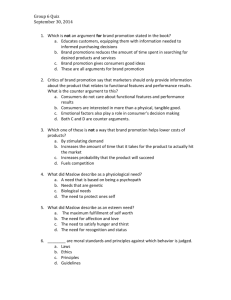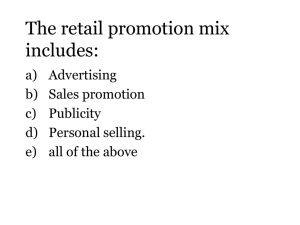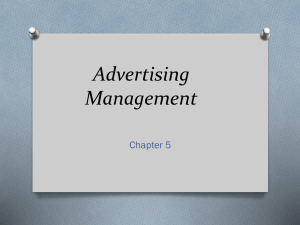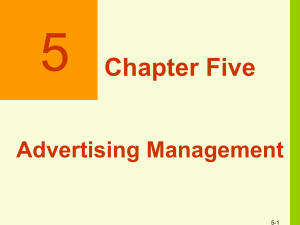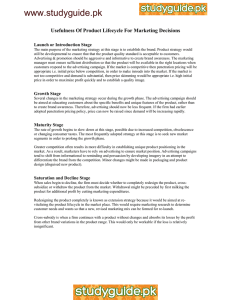,&~';: J:1-CA/lIU~
advertisement
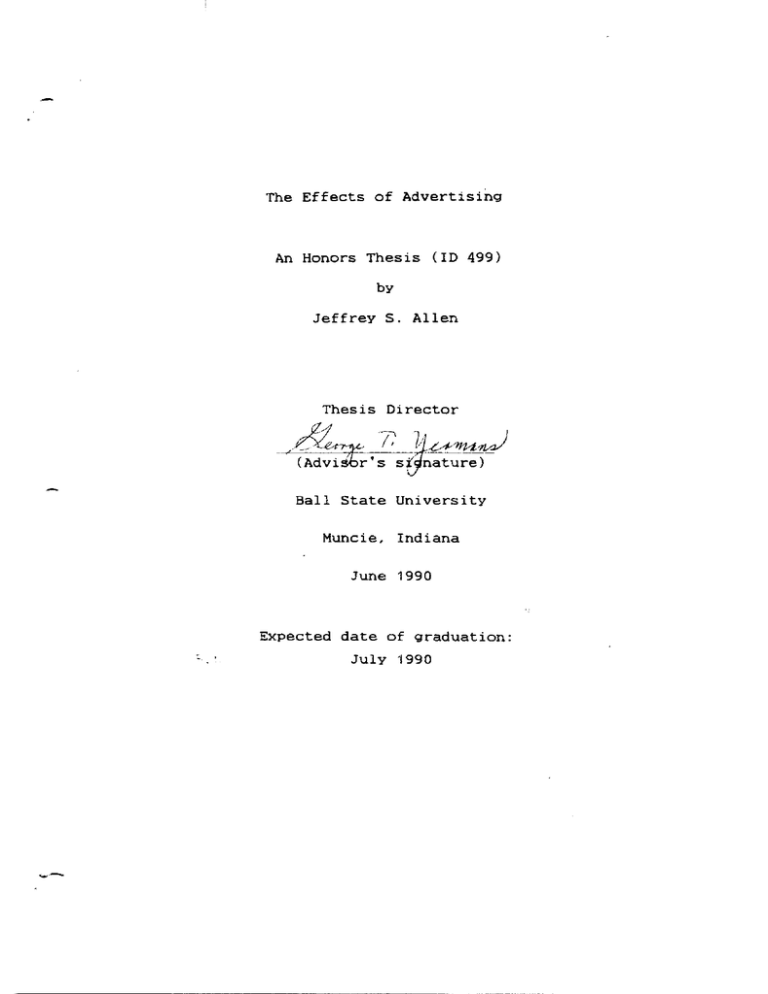
The Effects of Advertising
An Honors Thesis (ID 499)
by
Jeffrey S. Allen
Thesis Director
,&~';: J:1-CA/lIU~
(Advi
r's st1nature)
Ball State University
Muncie,
Indiana
June 1990
Expected date of graduation:
July '1990
r
_ ' i
--'t-'{/. ("
, (f'
. II
I~:-
In 1989 total advertising expenditures in the United
States exceeded 125
billion dollars-a figure expected
to increase in 1990.
As a result, the average American
citizen is constantly being flooded in a sea of "spots."
There is television, radio, outdoor(posters, billboards,
and park benches), newspapers, buses, trucks, taxicabs,
matchbooks, direct mail, and now even movies.
Moreover,
as Jack Trout and Al Ries note in their book Positioning:
The Battle for Your Mind, "even the human body has
become a walking billboard for Adidas, Gucci, Benetton,
and Gloria Vanderbilt(9-10)."
ments are unavoidable.
esting question:
Simply put, advertise-
Therefore, this raises an inter-
to what extent do these messages
affect consumer attitudes and behavior?
Much of the research examining advertising or
communication effects concentrates on controlled verbal
processes and their resultant effects on the beliefs,
--
attitudes, and consumption of the advertised brand.
For instance, the cognitive response approach to examin-
inQ advertisinQ effects focuses on the amount and type
of evaluative verbal processinQ.
In other words. this
approach is primarily concerned with the generation of
counterarquments and support arguments.
The cognitive
structure approach. on the other hand. emphasizes the
beliefs about the brand that are formed or chanQed after
exposure to the advertisement.
But experiments have
shown that neither of these approaches can completely
account for the noted variance in attitudes.
Therefore.
a third explanation is that there may be another. complementary approach to describing the attitude formation
and change process.
The approach that has been suggest-
ed is a measure of affective feelings about the advertisement(Mitchell & Olsen 18).
Although there is not
a complete understanding of this approach. it may
represent the transfer of affect through a nonverbal
channel.
For instance. attitudes may be transferred
from the commercial to the advertised brand by the
principles of classical conditioning(Staats & Staats
37-40).
A picture or words that evoke positive feelings
may. over time. be transferred to the brand.
Support
for this position comes from a study by Mitchell and
Olsen in 1981.
In this experiment. subjects saw a
number of different advertisements for hypothetical
facial tissue brands.
ings toward an
The results indicated that feel-
adver~isement
also explain the variance
in attitude and belief formation(Mitchell & Olsen 18).
Of course, each of these approaches can only be
explained within the context of numerous other factors,
which to some degree, affect the type and amount of
cognitive responses, cognitive structure, and feelings
generated toward the advertised brand.
For example,
attention levels and environmental factors(distracting
stimuli)both affect
the amount of mental processing.
A
study that manipulated attention levels found that
reduced attention levels affect the amount of attitude
change by blocking evaluative analYsis(Baron, Baron,
& Miller 310-323).
If the persuasive communication
causes subjects to generate mostly support arguments,
then partial attention will result in a less positive
attitude.
However, if the communication causes counter-
arguments to be generated during conditions of full
attention, then partial attention will result in less
negative attitudes(Petty, Wells,
&
Brock 874-884).
These results, though, require comprehension of the
message.
Otherwise, attitude formation is based upon
less judicious, emotional factors.
Messages that have a more complex meaning generally
require more attention(Britton, Westbrook, & Holdredge
582-591).
-.
Consequently, for a relatively simple message,
a particular low level of attention may allow for comprehension of the advertisement.
While the same level
of low attention can inhibit the comprehension of a
more complex message(Regen & Cheng 138-47).
Without a doubt. the amount and type of distracting stimuli has an affect on the amount of attention
devoted to an advertisement.
Obviously. as the distrac-
tion takes UP greater amounts of time. the quantity of
information from the message
be reduced.
stored in memory will
In addition. under these latter conditions.
"the resulting memory structure may be fragmented.
In
other words. associated concepts may be only weakly
linked to the brand(Harris(Mitchell) 31)."
Moreover.
"people are less able to differentiate strong from weak
arguments(Petty & Cacioppo 71-79)."
Not only the amount
of distraction. but also the type of stimuli have an
affect on a person's processing.
For instance. a dis-
traction that requires verbal processing such as
listening to the conversation of another person will
interfere with the verbal processing of information
from the advertisement.
However. interference with
the verbal channel does not block visual information
from being achieved(Harris(Mitchell) 31).
Therefore.
a distraction. in itself. does not guarantee that the
information presented is completely lost.
Aside from attention levels. the way in which a
-
person processes information also plays a role in determining how they interpret commercials.
One strategy.
which is called the brand strategy, is actively processinq the information from the advertisement with
the goal of forming an overall evaluation and to
acquire information about the advertised brand.
Alternatively, individuals may have some other goal
during exposure to the advertisement, such as enjoyment
of the advertisement's entertainment aspects.
are called nonbrand strategies.
These
According to one study,
"these two processing strategies
will gen~rally cause differences
in the resulting content and
organization of information from
the advertisement in memory. Both
strategies cause a trace of the
advertisement to be retained in memory, however, the brand strategy
also results in a well-integrated
network of concepts organized about
the brand.
In contrast, a nonbrand strategy appears to result
in a weakly linked set of knowledge
about the mind ... these two types of
strategies resulted in differences
in the amount of time required to
verify information about the brands
and the resulting attitudes toward
the brands. The group executing
the non brand strategy took longer
to verify information about the
brands and formed more positive
attitudes(Harris(Mitchell, Gardner,
& Russo) 1982).
So what determines which strategy is used?
That depends.
The individual actually interested in buying a new car
will employ a brand strategy while watching automobile
commercials.
But the person, who neither needs nor
wants a new car, will employ a nonbrand strategy.
only makes sense that what an individual looks for
It
determ1nes, in part, the information discovered within
the advertisement.
We see what we want or need to see.
Individual factors-knowledge and social status-also
affect the cognitive processing that occurs during exposure to an advertisement.
With little prior information
about a brand, an individual will experience difficulty in comprehending a complex and highly technical
advertisement.
Furthermore, with little product
knowledge, an individual generates significantly fewer
counterarguments(Harris(Mitchell) 35).
On the other
hand, as a message is repeated a moderate number of
times, there is a greater opportunity to think about
the arguments presented and to show a greater differentiation between reasonable and deceptive arguments
(Cacioppo &
Pe~ty
78).
As for social status, two
studies reveal that advertising has a greater effect
on the purchase decisions of lower-class individuals
than on those of higher socio-economic classes.
What's
more, fear appeals are more effective with blue-collar
workers than with white-collar workers(Peretti & Lucas
693-94; Burnett & Wilkes 21-24).
An advertisement's characteristics such as modality
(the amount of time that an individual has to process
the information), context, and structure(print, audio,
or video)also affect cognitive processing.
In some
circumstances, modality may be a function of structure.
With print advertisements, for example, an individual
can spend as much tlme as he/she prefers when considerinq the messaqe.
But of course, other factors(e.q.,
a phone call, children,or with broadcast media, the
lenqth of the advertisement)will also control processinq time.
One study indicates that fewer counterarqu-
ments are generated when processing time is limited
(Wright 192-205).
As for the content of an advertisement, several
theories have been developed.
learninq theory.
First, there is the
This hypothesis, presented by Fishbein,
argues that attitude chanqe is greatest when a commercial presents strong arguments to support broad claim(s)
as with a product demonstration.
He argues that these
advertisements produce more favorable brand attitudes
and behaviors(233-240).
One study by Burke Marketing
Research, Inc. supports this assumption.
According to
the study, the strongest impact on recall scores appeared
to stem from the use of product demonstrations in
television commercials(Albion & Farris 17).
Another
researcher contends that an effective message will
"prove" that a product has a particular attribute.
From here, attitudes are chanqed by facilitating
learninq and eventual acceptance of the information
(McGuire 1972).
The second theory suqgests that an advertisement
does not need to provide specific, proven information
to be successful. Rather, unsubstantiated claims about
a brand's desirable attributes--"the strongest decongestant YOU can buy"--are very powerful in convincing
the consumer.
These researchers believe that persua-
sion is mediated by the thoughts generated by the
receiver as the communication is received and processed.
That is, people are not passively persuaded by raw
information.
Actually, they actively evaluate infor-
mation and in doing so, literally persuade themselves.
This model was originally developed by Olson, Toy,
and Dover.
And together, they predict, and have demon-
strated empirically, that exposure to a commercial
may also spontaneously evoke unexpected thoughts about
benefits that the advertised brand is not able to deliver.
In other words, according to their model, a
message can persuade by stimulating people to remember
or infer brand relevant information that is not contained
in the actual advertisement(245-262).
The third theory attempts to explain the nonmessage
cues which lead to brand allegiance.
A typical cue is
the expertise, attractiveness, and trustworthiness of
a spokesperson.
These cues are referred to by Pechmann
and Stewart as heuristic cues.
And they state that,
"whereas claims that are processed
systematically must be substantiated,
claims that are processed heuristically need not be. The effectiveness
of the heuristic cue, not the
1
...IIiii6I-
".
information itself, is what determines whether the message will be
accepted. Thus ads that employ
heuristic cues may use puffery or
make unsubstantiated assertions ...
(and) promote brand sales without
changing beliefs about the brand's
specific attributes(Cafferata &
Tybout(Pechmann & Stewart) 41).
Although this method of processing is not the most
reliable and accurate means of judging the validity
of a claim, nevertheless, consumers may employ such
heuristic cues when economy of effort is important.
The fourth theory is the low involvement model,
described by Lavidge and Steiner.
While it is very
similar to the heuristic model, this theory is more
specific.
The assertion is that people rely on the
simplest of cues-name, logo, or packaging(Lavidge &
Steiner 53-62).
And according to Ray and Batra, adver-
tisements often use emotion-laden stimuli such as color
and imagery to increase the attractiveness of the
brand name, logo, or packaging(543-548).
Therefore,
processing of a commercial may involve emotional reactions to less predictable signals.
As Pechmann and
Stewart state, "people buy these brands on the basis of
the simplest of choice heuristics:
'I'll buy· it because
it looks familiar to me'(Cafferata & Tybout 41)."
The last theory is classical conditioning.
Accord-
ing to this theory, favorable attitudes are formed
indirectly.
The advertisement associates a product
,
--
with pleasant ideas, scenes, or items.
After seein9
such a commercial numerous times, the viewer assumes
that the product also has these pleasant, desirable
attributes.
Clouds and toilet paper, teddy bears and
fabric softner, and Ronald Reagan's "Morning in America"
sPOts are prime examples of this classical conditioning
model at work.
Pechmann and Stewart believe that,
"an ad that is entertaining or heartwarming presumably can enhance
more favorable brand attitudes ...
even if there is no indication that
use of the brand itself will be entertaining or heartwarming. Many
ads that use emotion apparently
do so simply to create a good
feeling about the brand, regardless
of whether one of the brand's most
salient benefits is emotional
(Cafferata & Tybout(Pechmann &
Stewart) 43)."
Clearly, information that is presented in a unique
way will cause the individual to devote more attention
to the advertisement; therefore, more knowledge about
the brand is retained.
As for the structure of an advertisement, audio,
video, and print advertisements each evoke different
cognitive responses.
While the two broadcast media
generate more annoyance responses and are considered
less informative, Wright found that more counterarguments were generated when information was presented
through print media.
But most studies focus, not on
the comparisons of broadcast and print media, but
· --
.
on the different effects of words and pictures.
For
instance, evidence sUQQests that pictures are remembered better than words--a phenomena termed "hypermnesia"
(Erde1yi & Becker 158-171).
In a more specific study,
subjects were shown 612 illustrations from maQazine
advertisements and were able to remember a median of
98.5
% of the pictures that they had been shown(Shepard
156-163).
Of course, certain pictures are more effec-
tive than others.
LOQos that included a pictorial
depiction of a brand name facilitated recall, but logos
that only showed the product, did not help the viewer
remember a company's name(Lutz & Lutz 493-98).
In a study, thouQh, that did focus on the differences between video and print, Grass and Wallace found
that television commercials produced siQnificant1y
Qreater recall of messaQe points than specially matched
print advertisements which used a "main frame" from
the commercial as the COpy.
Overall, recall was
superior for television by 81 % to 56 %, and recall
of the main messaQe point was superior by 75 % to 39 %
Grass & Wallace 19-23).
Grass and Wallace hypothesized
that the superior performance of television commercials
was due to the Qreater amount of attention paid to the
broadcast presentations.
Obviously, the ability to
recall a message does not necessarily result in purchasing the advertised brand, but it is not surprising
that people. for the most part. buy products they are
familiar with and trust.
This brings us back to the original question-to what extent do advertisements affect consumer behavior and attitudes?
Do
individuals spend more and
become materialist1c as a result of hundreds of advertisements?
If so. is there a specific dollar amount
increase in purchases?
Unfortunately. the simple.
unsatisfying answer is that researchers do not completely
underst.and the effects of advertising.
They do know.
though. that attention levels. environmental factors.
processing strategy. individual factors. and message
characteristics each help to explain some of the
results. but only some.
As a matter of fact. advertising
may never be completely understood.
But ultimately.
the one thing that really matters is that it works ...
and that is something advertisers can literally bank
on!
--
.
BIBLIOGRAPHY
Albion, Mark S. and Farris, Paul W. The Advertising
Controversy:
Evidence on the Economic Effects of
Advertis~
Auburn House Publishing Co.
Boston
Massachusetts.
1981. pg. 17.
"The Relation
Baron, R.S., Baron, P.H., and Miller, N.
Between Distraction and Persuasion." PsYchological
Bulletin.
1973. pgs. 310-323.
Britton, B.K., Westbrook, R.D. and Holdredge, T.S.
"Reading and Cognitive Capacity Usage:
Effects of
Text Difficulty." Journal of Experimental PsYchology: Human Learni~and Memor~ 1978. pgs. 582-91.
"Fear Appeals to
Burnett, John J. and Wilkes, Robert.
Segments Only." Journal of ftdvertising Research.
1980. Vol. 20, No.5. pgs. 21-4.
Cacioppo, J.T. and Petty, R.E.
"Persuasiveness of Communications is Affected by Exposure Frequency and
Communication Cogency: A Theoretical and Empirical
Analysis of Persisting Attitude Change." Current
Issues and Research in Advertising~ 1980.pgs. 71-9.
Cafferata, P. and Tybout, A.M.
Responses to Advertis~
pgs. 36-41. 43.
Cognitive and Affective
Lexington Books. 1989.
Erdolyi, M.H. and Becker, J.
"Hypermnsia for Pictures'
Incremental Memory for Pictures But Not Words in
Multiples Recall Trial." Cognitive Psychology.
1 '374 . pgs. 1 58 - 71 .
Fishbein, M.
"An Investigation of the Relationships
Between Beliefs About an Object and Attitude
Toward the Object." Human Relations.
1963. pgs.
16: 233-40.
Grass, R.C. and Wallace, W.H.
"Advertising Communication:
Print V.S. TV." Journal of Advertising
Research.
197~
Pgs. 19-23.
Harris, R.J.
Information Processin'L-Research in Advertising.
Lawrence Erlbaum Associates, Publishers.
Hillsdale, New Jersey. 1983. pgs. 31, 35.
Lavidge, Robert J. and Steiner, Gary A.
"A Model for
Predictive Measurements of Advertising Effectiveness."
Journal of Mark~ti~ 1961. pgs. 25: 53-62.
BIBLIOGRAPHY
Lutz, K.A. and Lutz, R.J.
"The Effects of Interactive
Imaqery on Learninq: Application to Advertisinq."
Journgl of Applied Psychology.
1977. pqs 493-8.
McGuire, W.J. "Attitude Chanqe: The Information
Processing Paradiqm." Experimental Social PsYcholQSl)L. 1972.
MitchelL A.A. and Olsen, J .C. "Are Product Attribute
Beliefs the Only Mediator of Advertisinq Effects
On Brand Attitudes?" Journal of Marketing Research.
1981. pg. 18.
Olsen, Jerry C., Toy, Daniel R., and Dover, Philip A.
"00 Cognitive Responses Mediate the Effects of
Advertising Content on Cognitive Structure?"
Journal of Consumer Research.
1982. pgs. 9:245-62.
Percy, L. and Woodside Arch G. Advertising and Consumer
Psychology.
Lexington Books.
1983. pgs. 6-8,133.
Peretti, Peter o. and Lucas, Chris. "Newspapers Advertising Influences Consumers Behavior by Socioeconomic Status of Customers." Psychological
Reports. Vol. 37, No.3. pgs. 693-4.
Petty, R.E., Wells, G.L., and Brock, T.C.
"Distraction
Can Enhance or Reduce Yielding to Propaganda:
Though Disruption Versus Effort Justification."
Journal of Personal i ty and Soci.al Psychology. 1976.
pgs. 875-84.
Ray, Michael A. and Batra, Rajeev.
"Emotion and
Persuasion in Advertising: What We 00 and Don't
Know About Affect." Advances in Consumer Research.
1983. Vol. 10. pgs. 543-8.
Regen, D.T. and Cheng, J.
"Distraction and Attitude
Change Resolution." Journal of Experimental
Soc a"'l"--'P"'s~y....,.c"'h"o.LI..,o"""g-"y~. 1973. pgs. 138-47.
1",-·. .
Shepard, R.N.
"Recognition Memory for Words, Sentences
and Pictures." Journal of Verbal Learning and
Verbal Behavior.
1967. pgs. 156-63.
Singer, B.D. Advertising and Society~ Addison-Wesley
Publishers, Limited.
1986. pg. 64.
Staats, A.W. and Staat, C.K.
"Attitudes Established
By Classical Conditioning." ,Journal of Abnormal
and Social Psycholo~ 1958. pgS 37-40.
-~
.
BIBLIOGRAPHY
Trout, Jack and Ries, Al.
Positioning:
Your Mind.
1980. pqs. 9-10.
The Battle for
Wriqht, P.L.
"Analyzing Media Effects on Advertisinq
Responses." Public Opinion Quarterly. 1974.
pqs. 192-205.

